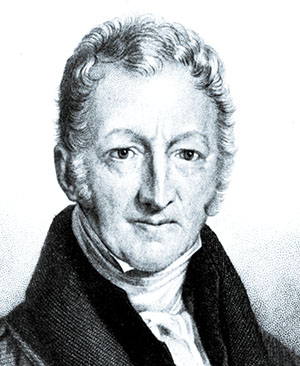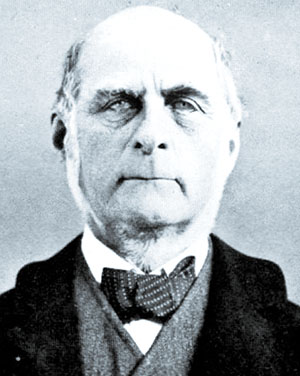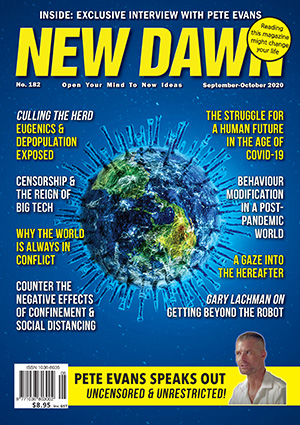Culling the Herd: Eugenics, Depopulation & the Extermination of Lower Classes
From New Dawn 182 (Sept-Oct 2020)
Eugenics is an attempt to produce genetically desirable children and to terminate the lives of those considered to be genetically inferior. Elements of eugenics exist everywhere. For example, when given the choice, people produce children with partners whom they find attractive. Part of them hopes that those attractive qualities will manifest in the offspring. A more extreme form is infanticide: killing children usually because of physical or mental deformity; a practice as old as humanity.1 In Ancient Greece, Plato and Socrates (c. 470-399 BCE) suggested ways of breeding to promote the superior traits of the elite, as sickly infants were deliberately left to die of exposure.2
Today, there is a sensible and ethical side of what is often called eugenics. Examples include disabled children having operations to save their lives and individuals with learning difficulties asking for sterilisation because they can’t manage contraception and don’t want children. But institutions like the state, prisons, and medical facilities, as well as privileged elites, use eugenics as a way of trying to exterminate the elements of society whom they consider to be a burden. What started out as selective breeding and infanticide has today developed into forced sterilisation and genetic editing to produce “designer babies.” This thinking also informs certain depopulation agendas.
ORIGINS OF THE THEORY
In 1866 in Imperial Russia, the obstetrician Vasilii Florinskii authored a book advocating for scientific methods to improve human traits. Given the poverty of Russia at the time, there were no medical facilities to realise Florinskii’s ideas.3 Russia would not endure a eugenics programme until the Bolsheviks seized power in 1917. In Germany, the term “racial hygiene” (Rassenhygiene) was coined in 1895 by the biologist Dr Alfred Ploetz (1860-1940). The notion later informed Nazi thinking on eugenics.
The British biologist Sir Francis Galton (1822-1911) coined the term eugenics (meaning of good birth) and described it as “the science of improving inherited stock, not only by judicious matings, but by all the influences which give more suitable strains a better chance.”4Galton was inspired by his cousin, Charles Darwin (1809-82), who was cautious about eugenics. The influential book An Essay on the Principle of Population(1798) written by the economist, Thomas Malthus (1766-1834), also influenced Galton. In it, Malthus argued that unlimited population growth was unsustainable. More inspiration came from Herbert Spencer (1820-1903), the sociologist who coined the term “survival of the fittest.”5In 1907, Galton established the University of London’s Eugenics Laboratory.
In Germany, Wilhelm Schallmayer (1857-1919) authored popular books concerning selective breeding among elites to further “civilisation.”6 Just as US eugenicist groups were sponsored by corporate foundations, Schallmayer was promoted by Krupp, the German industrial giant. Most early feminists opposed abortion, so eugenics was, in many ways, a proxy for abortion. In the 1900s, Germany’s Bund für Mutterschutz (Organisation for Maternal Protection) saw feminists and socialists advocate for eugenics in an effort to own their bodies and gain credence in the male-dominated science milieu. The BfM was established by Elisabeth Bouness (Ruth Bré, 1862-1911), who fostered support groups for single, unwed mothers. Other, more right-wing eugenicists like Agnes Bluhm (1862-1943), dismissed the BfM’s utopianism. Men, conversely, tended to see eugenics as an opportunity to further their control over female bodies.

Inspired by Malthus, the British Eugenics Education Society was founded in 1907 by Sybil Gotto (1885-1955) and headed by Galton. Forty-percent of its members were women. For many feminists, male dominant sexuality produced “maimed, diseased, unwanted babies.” Dora Marsden (1882-1960), editor of Freewoman, opposed the Eugenics Education Society (EES) as “a conspiracy against the poor.” The Swedish feminist Ellen Key (1849-1926) explained that society should protect all “except that which gives occasion to a weak offspring and produces bad conditions for the development of that offspring.”7
Eugenicists relied on biology to try to define superior and inferior characteristics. They utilised statistics to try to prove that the lowest classes of people were outbreeding the highest. EES members like the mathematician and later Ministry of Food statistician, David Heron (1881-1969), explained that: “higher net fertility is shewn… to be very markedly correlated with the most undesirable social factors (sic).” We now know that poverty can cause serious cognitive problems in developing brains. At the time, poverty-related impaired cognitive function – then called “feeble mindedness” – was falsely attributed to genetics. A 1912 report by the Committee to Consider the Eugenic Aspect of Poor Law Reform refers to the “feeble-minded” – who could not work and were of negative value to the capitalist class – as “the chief burden on the public purse,” as they required health and social care; both of which were still in their infancy. British eugenicists failed in their lobby to legalise for forced sterilisation,8 passing instead the Mental Deficiency Act 1913, which sought to institutionalise people with particular needs. Many British female eugenicists opposed the Act because it primarily targeted single mothers.9
The British economist John Maynard Keynes (1883-1946) is credited with influential theories concerning state-planning over national economies. Keynes believed that law and other coercive measures could be imposed on population abroad to improve their living standards by reducing their overall numbers. In 1914, for instance, he wrote: “In many, if not in most, parts of the world there actually exists at the present time a denser population than is compatible with a high level of economic wellbeing.”10
FROM BRITAIN TO THE USA
According to some scholars, 19th-century pedigree animal breeding inspired US eugenics, with the American Breeders Association splintering to form the eugenics movement.11 By the 1910s, US states, particularly in the south, hosted “Better Babies” competitions, in which the mental and physical characteristics of infants were measured and tabulated by eugenicists.12 Writing for American Breeders Magazine in 1910, C.B. Davenport (1866-1944), director of the Cold Spring Harbor Station for Experimental Study of Evolution, argued that “society must protect itself” from the so-called feeble-minded by “segregation” or even sterilisation. American eugenicists established the Carnegie-funded Eugenics Record Office.13

The US socialist, feminist, and birth control advocate, Margaret Sanger (1879-1966), opened America’s first birth control clinic in New York in 1916. Sanger also helped to create the organisation Planned Parenthood. But these progressive steps masked another agenda.14Sanger was a strong advocate for eugenics, even speaking about the subject at a Ku Klux Klan meeting to white supremacists, who had an interest in wiping out the Black population.15 In 1924, the psychologist and feminist, Leta Hollingworth (1886-1939), explained that “the very intelligent are those who rise in the world of competition, and who are also able to produce children like themselves.” Sponsored by eugenics societies, “Fitter Families” competitions awarded medals, inscribed with: “Yea, I have a goodly heritage.”16
In the US, eugenicists were behind the Immigration Act 1924 which limited the entering into the US of foreign paupers whom the establishment considered genetically inferior.17 In 1927, US Justice Oliver Wendell Holmes affirmed the constitutionality of forced sterilisation when he decreed in the case of Carrie Buck (who was erroneously thought to have had learning difficulties) vs. John Hendren Bell (a eugenicist): “three generations of imbeciles are enough.” (Buck’s mother had also been misdiagnosed with mental disorders.)18 After Buck v. Bell, a dozen US states felt empowered to enact sterilisation laws against the institutionalised.19
By the mid-1930s, eugenicists recognised their failure to turn their theory and practice into a science. But there was no clear demarcation and eugenicist ideas developed as “reform eugenics.” The majority of eugenics sterilisation in the US was conducted between 1930 and 1960.20 Into the 1970s, federally-funded US medical facilities continued to quietly perform forced sterilisation, usually on Black women; the most high-profile case being that of Minnie and Mary Relf, aged 12 and 14. Other cases included the sterilisation of Mexican migrant women by Californian obstetricians.21 In 1975, the federally-funded Indian Health Service sterilised 25,000 Indigenous women.22
As part of its population-reducing, one-child policies, between 1971 and 2013, Chinese state and local authorities forced 200 million sterilisations and over 330 million abortions on lower-class women, offering wealthier families the chance to offset their breeding by paying “social compensation” fees. As part of India’s so-called Emergency, declared in 1975 in response to population booms, India began the forcible sterilisation of 10 million people by 1977. Later, allegedly softer measures were imposed, such as financial incentives for poor families to undergo sterilisation: 90 percent of the victims were women and included 4.6 million people in the year 2012 alone. In the poorest state, Bihar, 13,000 medical camps were established to sterilise 650,000 women.
GIVING EUGENICS A BAD NAME
In 1920, the German jurist Karl Binding (1841-1920) and the psychiatrist Alfred Hoche (1865-1943) co-authored the book, Permitting the Destruction of Life Unworthy of Living (Die Freigabe der Vernichtung Lebensunwertes Lebens), in which they gave legal and medical justifications for murder as mercy killing (euthanasia). Their text cites eugenics and social Darwinism. Rejected by most physicians at the time, the Binding-Hoche thesis informed Nazi eugenics policy.23
Between the mid-1920s and the close of the Second World War, 60,000 Americans were forcibly sterilised. After the Nazis gave eugenics a bad name, US sterilisation typically occurred behind closed doors in institutions.24
In 1930s Germany, conditions including epilepsy, manic-depression, and schizophrenia were attributed solely to Mendelian regressive genes.25 When the Nazis came to power in 1933, they legislated to have physicians send patients with particular needs, including physical and mental, to sterilisation courts where judges, panels, witnesses, and medical professionals would decide their reproductive fate.26 The Nazis promoted Lebensborn (Fount of Life) to increase the birth-rate of “Aryan” children.27 At least 350,000 Germans were forcibly sterilised by the Nazis up to 1945. Because sterilisation was legal in many US states, the Nazis were not tried at Nuremberg for eugenics.28
By the mid-1930s, more than half of Germany’s physicians had joined the Nazi Party, seeing themselves as “biological soldiers” in the war against racial impurity. “Defective” German children were left to die of starvation and exposure in unheated wards. Others were poisoned with cyanide. Nazi Germany’s forced sterilisation law was also imposed on the countries it occupied, including Austria and Norway. The mass murder of “unfit” adults was usually conducted by morphine injections and the issuance of fake death certificates. By 1939, over 200,000 people had been murdered in the T4 eugenics programme.29
EUGENICS & DEPOPULATION
One of the more unusual chapters in the history of the eugenics-depopulation agenda pushed by some elites concerns the Georgia Guidestones. Elberton, Georgia, is known as the granite capital of the world.30 In 1979, one Robert C. Christian (pseudonym) commissioned Joe H. Fendley (c. 1935-2005), President of the Elberton Granite Finishing Company, to construct the five, capped slabs of the 19-feet-high monument to “The Age of Reason.” The Guidestones’ inscribed “ten commandments” include depopulation and eugenics: “Maintain humanity under 500,000,000 in perpetual balance with nature. Guide reproduction wisely improving fitness and diversity.”

We’ve seen how the elites feared being outbred by the riffraff. This theme continued into the late-1960s, with fears that third world populations were breeding out of control and threatening the resources of the privileged. Many of the theories were presented as humanitarian, that the poor hadn’t enough food and space to live worthwhile lives. This was popularised by the biologist, Paul Ehrlich (born 1932), whose book The Population Bomb (1968) presented an internationalist argument for population control through education, contraception, and financial inducements. Under cover of philanthropy, the book pushed an environmental agenda. Notably absent from the book is a critique of capitalism, which observes that children starve because poor countries export food to rich markets, that big industry poisons children as a consequence of profit-seeking, and health systems are often privatised.
Founded in the same year as Ehrlich’s book, the Club of Rome was set up by Aurelio Peccei and Alexander King. Its book The Limits to Growth (1972, Universe Books) made much the same arguments as Ehrlich. In 1988, the Club of Rome welcomed a speech by Britain’s Prince Philip (born 1921). In the same year, the noble Prince told German media: “In the event that I am reincarnated, I would like to return as a deadly virus, to contribute something to solving overpopulation,”31 and in doing so exposed the antihuman thread that underlies some of the environmental movement. Infamously, another Club of Rome endeavour, The First Global Revolution (1991), argued that humans need a common enemy. Where states and religious minorities fail to act as that enemy, “the new enemy” would be “humanity itself.” Of course, the Club of Rome’s limited budget was no match for the oil industry, which swamped public opinion with climate change denial propaganda, so their agenda largely failed.
Climate change deniers attacked sustainability initiatives such as the United Nations Conference on Environment and Development’s document, Agenda 21, a nonbinding, failed roadmap towards sustainability.32 In fairness to those who see conspiracy, the UN Environment Programme’s co-founder and energy businessman, Maurice Strong (1929-2015), told the Earth Summit 1992: “We are now a species out of control. Our very success is leading us to a dangerous future… [O]verall, this [population] growth cannot continue… Population must be stabilised.”33
The global corporate system has extracted material wealth from the third world, including food and minerals. In doing so, it has facilitated third world overpopulation (China pop. 1.4bn, India 1.3bn), because poor people tend to have more children than middle-class people due to factors including lack of sex education, the unavailability of contraception, religious indoctrination, male domination, and efforts to increase the likelihood of offspring survival by bearing large numbers of children.
In richer countries, like those of North America, Europe, and Australasia, fertility has declined drastically. The wealth that is sucked out of the third world causes socioeconomic changes in the West, where people have affluence in the form of smartphones and packaged holidays but no real wealth in terms of affordable housing or savings. This makes it difficult to raise families. It takes two people to make a baby. That means if the fertility rate is two children per female in her lifetime, global population will not significantly fall or rise above its present rate. Globally, the average number of children per female was 4.7 in 1950, hence the rapid growth of the world’s population. But by 2017, it was 2.4. Across Western Europe, it is 1.7, meaning that Europe is in demographic decline.34
Unlike the ideologies of the recent past, like those of the Club of Rome, today’s depopulation agenda has coupled with big oil. The Michael Moore production, Planet of the Humans (2020), uses outdated and often false information about renewable energy to attack the green movement (big oil agenda) while simultaneously interviewing privileged middle-aged-to-elderly white males about how people of colour in poor countries are killing the planet (Club of Rome-type agenda). The filmmakers’ solution to overconsumption is depopulation.
EUGENICS TODAY
Today, genetic screening and gene editing have the potential to realise the dreams of eugenicists. Part of their agenda is to own life, while the agenda of the corporations to which some of them ally is purely to make money. This can be done, in part, via patenting genes: the building blocks of life.
The patenting of life began in 1971. Dr Ananda Chakrabarty (1938-2020) of the giant corporation, General Electric, applied to the US Patent and Trademark Office (PTO) to register a genetically-modified organism (GMO), which he’d engineered to eat oil spills. The PTO rejected the application on the grounds that living things are not patentable. Chakrabarty appealed to the Court of Customs and Patent Appeals, whose judges voted in his favour. The decision allowed anything but a “complete” human being to be patented. Since then, the race to patent every gene and combination means that corporations and entrepreneurs own 20 percent of the human genome via 40,000 patents.35 In 1984, after one John Moore (1945-2001) attended the University of California-Los Angeles for cancer treatment, the University together with the Sandoz Pharmaceutical Corp. obtained and patented his spleen cells (making $3 billion in the process), without Moore’s knowledge or consent. In 1990, the Supreme Court of California ruled that Moore had no rights over his cells. By 2003, 127,000 patent applications were filed for human genes and sequences.36

In 1998, the geneticist Dr David J. Galton, a relative of Sir Francis, wrote not of the immorality of eugenics but of the need for better regulation: “To prevent such abuses in the future statutory bodies, such as a genetics commission, should be established to provide guidance and rules of conduct.”37 In 2003, the geneticist Charles Epstein wrote: “modern human genetics and medical genetics… are eugenic – if not a literal return to the eugenics of the past, at least a reincarnation of that eugenics in a new guise.”38 Between 2005 and 2016, dozens of female prisoners were sterilised in California without their informed consent.39 Historian Daniel J. Kevles says that humanity “now possesses tools to reshape its own hereditary capacities, perhaps even to realise the dream of eugenicists that human beings might take charge of their own evolution.”40
Today, dozens of gene-editing companies offer services in agbiotech, biobanking, cell therapy, DNA sequencing, stems, synthetic biology, and vaccines.41 These profit-seeking companies have the potential to work in the interests of eugenicists; for example, by editing genes to enhance certain traits desired by parents. Under the section “New Humans,” the UK Ministry of Defence notes that out to the year 2036: “The application of advanced genetics could challenge current assumptions about human nature and existence.” It goes on to note that, “[i]nitially employed for medical purposes, breakthroughs in these areas could be put to ethically questionable uses.” Examples include “the super-enhancement of human attributes, including physical strength and sensory perception.” It concludes that “[e]xtreme variation in attributes could arise between individuals, [or] between societies, creating additional reasons for conflict.” Another section of the report notes that “biotechnology and genetic engineering may be combined to create ‘designer’ bio-weapons to target crops, livestock, or particular ethnic groups” (emphasis in original). The document ends with reference to the final step in eugenics: ethnic cleansing. In referencing neutron weapons, which kill life and leave property undamaged, the MoD states: “The ability to inflict organic destruction, while leaving infrastructure intact, might make it a weapon of choice for extreme ethnic cleansing in an increasingly populated world.”42
CONCLUSION
This article has traced the thread of eugenics from our ancient past to the trans- and post-humanist visions of gene-editing tech-heads. The article has documented how eugenics can infringe upon human rights and even lead to genocide.
A final thought concerns elder care and social security in economically neoliberal states. In the UK, the policies of the ruling Tory party (2010-present) have, in the last decade, killed a quarter of a million economically useless Britons via fiscal austerity: old people who needed later-life care, disabled people claiming social security, and the most impoverished who depended on the state for their survival.43
In the minds of policymakers, eugenics is alive and well.
Get the issue this article appears in
Footnotes
1. Marianne Hem Eriksen (2013) World Archaeology, 49(3): 338-356
2. Timothy M. Reynolds (2009) Clinical Biochemical Reviews, 30: 187-96.
3. Nikolai Krementsov (2011) Annals of Science, 68(1): 61-92.
4. David J. Galton and Clare J. Galton (1998) Journal of Medical Ethics, 24(2): 99-105.
5. Philip R. Reilly (2015) Annual Review of Genomics and Human Genetics, 16: 351-68.
6. Reilly, op. cit.
7. Ann Taylor Allen (2000) German Studies Review, 23(3): 477-505.
8. Pauline M. H. Mazumdar (2002) Trends in Eugenics, 18(1): 48-52.
9. Allen, op. cit.
10. Quoted in Edward W. Fuller, Mises Institute, 14 November 2019, mises.org/wire/keynes-eugenics-race-and-population-control#footnote5_z3fncpw
11. Mazumdar, op. cit.
12. Steven Selden (2005) Proceedings of the American Philosophical Society, 149(2): 199-225.
13. Mazumdar, op. cit.
14. Reilly, op. cit.
15. Margaret Sanger (1938) Margaret Sanger: An Autobiography, NY: W.W. Norton & Co., pp. 366-67.
16. Selden, op. cit.
17. Mazumdar, op. cit.
18. Victoria Nourse (2016) Nature, 530: 418.
19. Reilly, op. cit.
20. Mazumdar, op. cit.
21. Reilly, op. cit.
22. Angela Gonzales et al. (2007) The Public Historian, 29(3): 53-67
23. Michael A. Grodin et al. (2018) AJPH, 108(1): 53-57
24. Reilly, op. cit.
25. Mazumdar, op. cit.
26. Grodin et al., op. cit.
27. Reilly, op. cit.
28. Mazumdar, op. cit.
29. Grodin et al., op. cit.
30. City of Elberton, “Welcome…,” no date, www.cityofelberton.net/
31. Quoted in Charlie Proctor, Royal Central, 14 March 2020, royalcentral.co.uk/uk/philip/prince-philips-deadly-virus-gaffe-139041/
32. United Nations Conference on Environment & Development, Rio de Janeiro, Brazil, 3rd to 14th June 1992, sustainabledevelopment.un.org/content/documents/Agenda21.pdf
33. Maurice Strong, Earth Summit Opening Plenary Part 2, 3 June 1992, www.c-span.org/video/?26478-1/earth-summit-opening-plenary-part-2
34. James Gallagher, BBC, 9 November 2018, www.bbc.co.uk/news/health-46118103
35. Chester S. Chuang and Denys T. Lau (2010) Clinical Therapy, 32(12): 2054-56.
36. See my Privatized Planet (2019, New Internationalist).
37. Galton and Galton, op. cit.
38. Diane B. Paul (2014) Science and Education, 23: 259-71.
39. Grodin et al., op cit.
40. Daniel J. Kevles (2016) Science and Technology, 32(3): 45-50.
41. Biotech-careers, no date, biotech-careers.org/company-core-activity/gene-editing
42. Ministry of Defence, The DCDC Global Strategic Trends Programme: 2007-2036, January 2007, pp. 79, 71, 85, ia800702.us.archive.org/28/items/strat_trends_23jan07/strat_trends_23jan07.pdf
43. See my article in The London Economic, 1 July 2020, www.thelondoneconomic.com/politics/tory-policies-have-killed-a-quarter-of-a-million-people-in-the-last-decade/01/07/
© New Dawn Magazine and the respective author.
For our reproduction notice, click here.
About the Author
![]()
– Come Like Us on Facebook – Check us out on Instagram –
– Sign Up for our Newsletter –



 www.newdawnmagazine.com
www.newdawnmagazine.com









